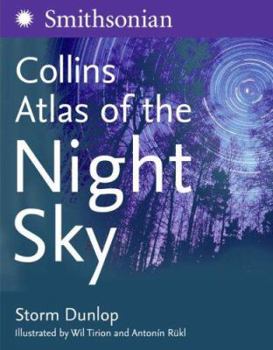Atlas of the Night Sky
Select Format
Select Condition 
Book Overview
Twenty large-scale star charts to a magnitude of 6.5 cover the whole sky, showing objects that can be seen with the naked eye, binoculars, & telescope. Charts illustrate all the individual... This description may be from another edition of this product.
Format:Hardcover
Language:English
ISBN:0060818913
ISBN13:9780060818913
Release Date:January 2005
Publisher:HarperCollins Publishers
Length:224 Pages
Weight:2.70 lbs.
Dimensions:1.0" x 9.1" x 11.4"
Customer Reviews
3 ratings
Collins Atlas of the Night Sky Storm Dunlop Illustrationed by Wil Tirion and Antonin Ruekl 1985
Published by Collins Atlas of the Night Sky , 3 months ago
Great Atlas! Includes all the constellations, has star charts ( up to 7.5 mag ) and WONDERFUL moon maps!! The moon is divided into 16 major areas and "giant print" drawings have great detail of lunar features. Alphabetical indexes of lunar features and constellations make this so easy to use. Time sensitive information i.e. eclipses, etc. is outdated but this book is worth the price for the moon maps, alone. The materials are quality so will stand up to repeated use. Anyone who looks up should read this book.
Not for the beginner
Published by Thriftbooks.com User , 16 years ago
This book requires a basic knowledge of astronomy to be appreciated. It has an enormous amount of details which will aid someone with a decent telescope to truly enjoy the night sky. The charts of the moon are incredible and anyone who looks up will benefit a great deal. Though somewhat advanced for many, it is a must have for any collection.
Well-produced observing guide covers all the bases
Published by Thriftbooks.com User , 19 years ago
Sometimes, it looks as though there are as many astronomy observing guides as there are astronomy authors, and all of them seem very much of a feather. That's why it's surprising why the pieces come together so well for the Collins Atlas of the Night Sky, by Storm Dunlop, Wil Tirion, and Antonin Rukl. With so much of this ground having been covered before, it's pleasantly surprising that they can present it so much better than others. Dunlop and Tirion have collaborated before, on the Firefly Deluxe Planisphere, a thick and large planisphere with rich detail and lots of information that puts David Levy's large planisphere to shame, for only twice the price. Rukl is known for his spectacular lunar atlas, recently reintroduced by Sky Publishing after a decade-long slumber in the out-of-print stacks. Make no mistake about it, these are some heavyweights in the uranography department. Much of this information can be obtained elsewhere. The book contains four main sections: an unaided-eye star atlas, a constellation guide, a lunar atlas, and a solar system observing guide. The star atlas is essentially drawn from the Cambridge Star Atlas, down to the same object list format. Twenty maps cover the entire night sky to a scale of about 3 degrees per centimeter, with stars to magnitude 6.5. Hundreds of deep sky objects are plotted and listed. To my initial puzzlement, I didn't find a map key, as there is in the Cambridge. I found it, after some searching, at the other end of the book, just before the index. The constellation guide, in turn, is quite reminiscent of the same section in Ian Ridpath and Tirion's Stars and Planets. The difference is that the Ridpath and Tirion book measures just 5-by-7, and each of the constellations is constrained to fit on a single page of that book. Here, each page is 9-by-12, and the constellation maps are given a generous scale of about 2 degrees per centimeter. Stars are plotted down to magnitude 7.5, so that the stellar density remains about the same in both the star atlas and the constellation guide maps. As in the Ridpath and Tirion book, each constellation is accompanied by an annotated list of several objects of particular interest within. Rukl's lunar atlas is drawn--hand-drawn, in fact--substantially from his well-known standalone Moon book, although the descriptions of each sector are given here in a more narrative style, rather than the spare, feature-by-feature description given in his own book. This makes it more suitable as an introduction to the Moon, though perhaps less so as a reference source for the experienced lunatic. Also, the scale is smaller than in his own atlas, with the Moon being divided into just 16 sectors, in a 4-by-4 square. A pair of map keys is given on each page of the atlas, with north up in both keys, but mirror-reversed from each other, to suit those observing with and without star diagonals. The last and slightest section covers solar system observing. A few pag






